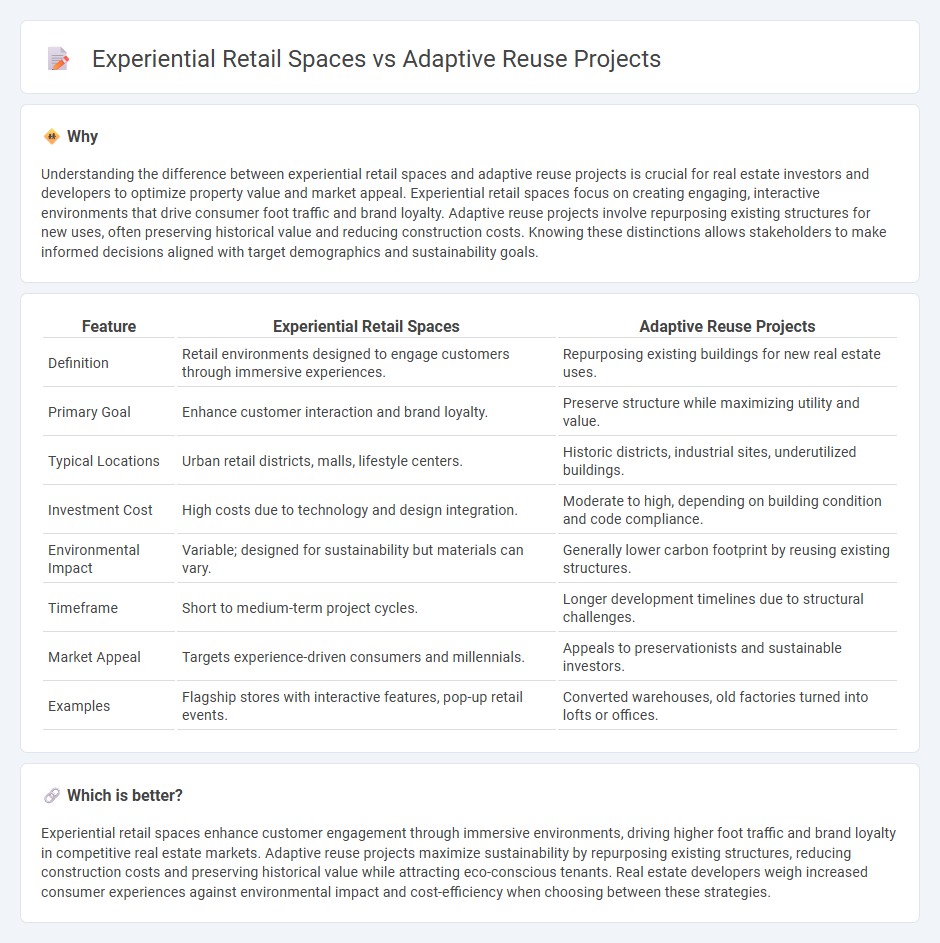
Experiential retail spaces focus on creating immersive, interactive environments that enhance customer engagement and boost sales by blending shopping with entertainment and technology. Adaptive reuse projects involve repurposing existing buildings for new commercial uses, preserving architectural heritage while promoting sustainability and reducing construction costs. Discover how these innovative real estate trends are transforming urban landscapes and retail markets.
Why it is important
Understanding the difference between experiential retail spaces and adaptive reuse projects is crucial for real estate investors and developers to optimize property value and market appeal. Experiential retail spaces focus on creating engaging, interactive environments that drive consumer foot traffic and brand loyalty. Adaptive reuse projects involve repurposing existing structures for new uses, often preserving historical value and reducing construction costs. Knowing these distinctions allows stakeholders to make informed decisions aligned with target demographics and sustainability goals.
Comparison Table
| Feature | Experiential Retail Spaces | Adaptive Reuse Projects |
|---|---|---|
| Definition | Retail environments designed to engage customers through immersive experiences. | Repurposing existing buildings for new real estate uses. |
| Primary Goal | Enhance customer interaction and brand loyalty. | Preserve structure while maximizing utility and value. |
| Typical Locations | Urban retail districts, malls, lifestyle centers. | Historic districts, industrial sites, underutilized buildings. |
| Investment Cost | High costs due to technology and design integration. | Moderate to high, depending on building condition and code compliance. |
| Environmental Impact | Variable; designed for sustainability but materials can vary. | Generally lower carbon footprint by reusing existing structures. |
| Timeframe | Short to medium-term project cycles. | Longer development timelines due to structural challenges. |
| Market Appeal | Targets experience-driven consumers and millennials. | Appeals to preservationists and sustainable investors. |
| Examples | Flagship stores with interactive features, pop-up retail events. | Converted warehouses, old factories turned into lofts or offices. |
Which is better?
Experiential retail spaces enhance customer engagement through immersive environments, driving higher foot traffic and brand loyalty in competitive real estate markets. Adaptive reuse projects maximize sustainability by repurposing existing structures, reducing construction costs and preserving historical value while attracting eco-conscious tenants. Real estate developers weigh increased consumer experiences against environmental impact and cost-efficiency when choosing between these strategies.
Connection
Experiential retail spaces often emerge through adaptive reuse projects, where underutilized or historic buildings are transformed into interactive shopping environments that enhance customer engagement. Adaptive reuse leverages existing architectural elements, contributing to sustainability and unique aesthetic appeal, which enriches the experiential retail concept. This synergy drives urban revitalization, attracting foot traffic and boosting economic activity in previously declining areas.
Key Terms
**Adaptive Reuse Projects:**
Adaptive reuse projects transform obsolete structures into innovative, functional spaces, preserving architectural heritage while promoting sustainability through reduced construction waste. These projects often enhance urban revitalization and cultural identity by repurposing historical buildings for modern commercial or community use. Discover how adaptive reuse can redefine space efficiency and economic value in urban landscapes.
Historic Preservation
Adaptive reuse projects prioritize historic preservation by transforming existing structures to maintain cultural heritage while integrating modern functionalities. Experiential retail spaces often emphasize immersive customer engagement but may pose challenges to preserving original architectural elements. Explore how adaptive reuse balances innovation with conservation to protect historic landmarks.
Zoning Regulations
Adaptive reuse projects often encounter zoning regulations that require conversion permits and compliance with historic preservation statutes, enabling the transformation of existing structures for new uses. Experiential retail spaces face zoning challenges related to commercial activity intensity, parking requirements, and signage restrictions designed to enhance customer engagement without disrupting local neighborhoods. Explore more about how zoning regulations shape the development and success of these innovative retail environments.
Source and External Links
Adaptive Reuse - Examples and Resources - This webpage provides examples of adaptive reuse projects, including transforming a former school into apartments and reusing other historic buildings for various purposes.
32 Adaptive Reuse Projects for a Better Future - This article highlights several international adaptive reuse projects, such as turning a former prison into an arts center and converting warehouses into senior care facilities.
8 Instances of Adaptive Reuse in India - This article showcases various adaptive reuse projects in India, including the transformation of historic sites like the Alembic Industrial Heritage development and Haveli Dharampura.
 dowidth.com
dowidth.com